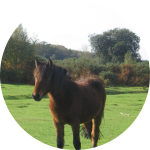|
It is natural to believe that wild horses have "always" roamed
America's Western States, but that simply is not the case.
Horses were native to North America until the end of the last
ice age, 10-12,000 years ago, and then they died out.
It took the joint actions of Christopher Columbus and Hernando
Cortez, to bring horses back to North America. In 1493, Christopher
Columbus brought horses from Spain to the West Indies, during
his second voyage to the Americas. In 1519, the Spanish conquistador
Cortez brought horses to the mainland, as the captain of the
third Spanish expedition.
Horses arrived in North America, by way of Mexico and Florida,
as a tool of the Spanish conquistadors and were used to great
effect by Cortez in the defeat of the Aztec empire.
Many horses went wild after their riders were killed. Other
horses escaped from their corrals, and many more horses were
integrated into Native American societies. Within just a few
decades, horses had migrated from Mexico and Florida and entered
into the North American interior.
The History of American Horse Breeds
Nearly all of the horses currently running wild in the ranges
of the Western United States hailed from the Iberian Peninsula
of Southwestern Europe, in a region defined by modern day
Spain, Portugal, Andorra and Gibraltar.
The Food and Agriculture Organization of the United Nations
suggests that there are 17 individual horse breeds that can
be defined as "Iberian horses". Three of the breeds hail from
Portugal and the remaining 14 originated in Spain. Most of
the Iberian horse breeds are considered to be Baroque horses,
comprised mostly of horses of Andalusian, Arabian and Barb
ancestry.
Many of the Native American tribes became master horse breeders,
most importantly, the Comanche, the Shoshoni, and the Nez
Perce nations. Through selective breeding by the Native American
tribes, the first truly American horse breed was the Appaloosa.
The wild horses of the Western United States are actually
more accurately referred to as horses that have gone "feral",
or horses that were once domesticated and now are wild. Just
as there is a huge population of feral dogs near the big cities
of America, most notably near Miami, Florida, there is also
a substantial population of feral horses in America.
Free-Roaming Horses Eventually Required Protection From
Congress
In 1900, it was estimated that there were as many as two
million free-roaming horses in the United States. During the
early years of the twentieth century, the free-roaming horse
population was severely diminished through a combination of
factors including the capture of horses for use in the military,
and more revoltingly, by companies who killed the horses to
make dog food.
By the 1970's, the plight of wild horses in the United States
had attracted the attention of the U.S. Federal Government.
This newly focused attention eventually led to the passage
of the Wild Free-Roaming Horses and Burros Act of 1971.
In recent years, it has been estimated by the U.S. Department
of Interior, Bureau of Land Management that there are as many
as 29,000 feral horses and burros on BLM-managed lands in
ten western states. The ten Western U.S. states that have
feral horses running wild includes: Arizona, California, Colorado,
Idaho, Montana, Nevada, New Mexico, Oregon, Utah, and Wyoming.
It is estimated that more than half of the wild horse population
resides in Nevada, and Montana and Oregon are the other states
with significant wild horse population numbers. There is another
few hundred head of wild horses free-roaming in Alberta and
British Columbia, in Canada.
Through the Wild Free-Roaming Horses and Burros Act of 1971,
the Bureau of Land Management has the responsibility of managing
the numbers of wild horses and burros, to ensure that healthy
herds thrive on healthy rangelands. Within the mandate of
the BLM, they are responsible to manage the herd numbers of
wild horses and burros that roam the American West.
The BLM Wild Horse and Burro Adoption and Sale Program
Wild horses left to their own wits can literally double their
population within four short years, provided that drought
and wildfires do not diminish their numbers naturally. Horses
do not have natural predators within the rangelands of North
America, so their numbers will generally run unchecked without
BLM intervention.
The beauty of the 1971 law is that as the BLM culls horses
and burros from the wild population, those horses and burros
will become available for adoption and sale through the BLM
program to individuals and groups willing and able to provide
humane, long-term care to these beautiful animals.
To learn more about the adoption of purchase of horses or
burros, you can visit the Bureau of Land Management website
at: http://www.blm.gov or give them a call at: (866) 4MUSTANGS.
You can actually adopt and purchase feral horses through the
BLM program in states on both sides of the Mississippi River.
Sales are held yearly throughout the South, the West and even
in Illinois.
About the Author
Phil Wiskell is a writer for HorseClicks.com, popular classifieds
of horses
for sale,
|


